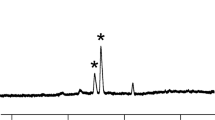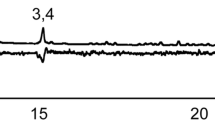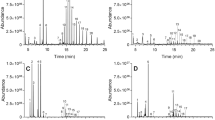Abstract
We examined whether shared volatiles found in various heteropteran species and developmental stages function to repel predators. The nymphal dorsal abdominal gland secretions of Riptortus pedestris (Heteroptera: Alydidae) and Thasus acutangulus (Heteroptera: Coreidae), and the metathoracic scent gland secretion of Euschistus biformis (Heteroptera: Pentatomidae) adults were identified by gas chromatography/mass spectrometry (GC/MS). (E)-2-Hexenal, 4-oxo-(E)-2-hexenal (4-OHE), and (E)-2-octenal were found in all three species and deemed likely candidates for repelling predators. In addition to (E)-2-alkenals, the adult E. biformis secreted (E)-2-hexenyl acetate, (E)-2-octenyl acetate, and four hydrocarbons. We evaluated the potential predator repellent properties of these compounds and compound blends against a generalist, cosmopolitan insect predator, the Chinese praying mantid (Mantodea: Mantidae: Tenodera aridifolia sinensis). Mantids that experienced (E)-2-hexenal, (E)-2-octenal, and (E)-2-octenyl acetate moved away from the site of interaction, while 4-OHE and (E)-2-hexenyl acetate did not affect mantid behavior. The compound blends did not have additive or synergistic repellency effects on predator behavior. Compound repellency was not related to compound volatility. Instead, the repellent effect is likely related to predator olfaction, and the affinity of each compound to receptors on the antennae. Our results also suggest the repellents might intensify the visual defensive signals of aposematism (T. acutangulus nymphs) and mimicry (R. pedestris nymphs) in heteropteran bugs.


Similar content being viewed by others
References
Aldlich, J. R., Oliver, J. E., Taghizadeh, T., Ferreira, J. T. B., and Liewehr, D. 1999. Pheromones and colonization: reassessment of the milkweed bug migration model (Heteroptera: Lygaeidae: Lygaeinae). Chemoecology 9:63–71.
Aldrich, J. R. 1988. Chemical ecology of the Heteroptera. Annu. Rev. Entomol. 33:211–238.
Aldrich, J. R. and Blum, M. S. 1978. Aposematic aggregation of a bug (Hemiptera: Coreidae): The defensive display and formation of aggregations. Biotropica 10:58–61.
Aldrich, J. R., Waite, G. K., Moore, C., Payne, J. A., Lusby, W. R., and Kochansky, J. P. 1993. Male-specific volatiles from Nearctic and Australasian true bugs (Heteroptera: Coreidae and Alydidae). J. Chem. Ecol. 19:2767–2781.
Aldrich, J. R., Rosi, M. C., and Bin, F. 1995. Behavioral correlates for minor volatile compounds from stink bugs (Heteroptera: Pentatomidae). J. Chem. Ecol. 21:1907–1920.
Blum, M. S. 1961. The presence of 2-hexenal in the scent gland of the pentatomid Brochymena quadripustulata. Ann. Entomol. Soc. Am. 54:410–412.
Borges, M. and Aldrich, J. R. 1992. Instar-specific defensive secretions of stink bugs (Heteroptera: Pentatomidae). Experientia 48:893–896.
Bowers, M. D. 1993. Aposematic caterpillars: Life-styles of the warningly colored and unpalatable, pp. 331–371, in N. E. Stamp and T. M. Casey (eds.), Caterpillars: Ecological and Evolutionary Constraints on Foraging. Chapman & Hall, New York, NY.
Brailovsky, H., Schaefer, C. W., Barrera, E., and Packauskas, R. J. 1994. A revision of the genus Thasus (Hemiptera: Coreidae: Coreinae: Nematopodini). J. N.Y Entomol. Soc. 102:318–343.
Chapman, R. F. 1998. The Insects. Structure and Function, 4th ed. Cambridge University Press, Cambridge.
Eisner, T. 1970. Chemical defense against predation in arthropods, pp. 157–217, in E. Sondheimer and J. B. Simeone (eds.), Chemical Ecology. Academic, New York, NY.
Eisner, T., Eisner, M., and Siegler, M. 2005. Secret Weapons. Defenses of Insects, Spiders, Scorpions, and Other Many-Legged Creatures. Belknap Press of Harvard University Press, Cambridge.
Gunawardena, N. E. and Bandumathie, M. K. 1993. Defensive secretion of rice bug, Leptocorisa oratorius Fabricius, (Hemiptera: Coreidae): A unique chemical combination and its toxic, repellent, and alarm properties. J. Chem. Ecol. 19:851–861.
Gunawardena, N. E. and Herath, H. M. W. K. B. 1991. Significance of medium chain n-alkanes as accompanying compounds in heteropteran defensive secretions: An investigation based on the defensive secretion of Coridius janus. J. Chem. Ecol. 17:2449–2458.
Hebets, E. A. and Papaj, D. R. 2005. Complex signal function: developing a framework of testable hypotheses. Behav. Ecol. Sociobiol. 57:197–214.
Kasai, H., Maekawa, M., Kawai, K., Hachisuka, K., Takahashi, Y., Nakamura, H., Sawa, R., Matsui, S., and Matsuda, T. 2005. 4-Oxo-2-hexenal, a mutagen formed by ω-3 fat peroxidation, causes DNA adduct formation in mouse organs. Ind. Health 43:699–701.
Kikuhara, Y. 2005. The Japanese species of the genus Riptortus (Heteroptera: Alydidae) with description of a new species. Jpn. J. Syst. Entomol. 11:229–311.
Krall, B. K., Bartelt, R. J., Lewis, C. J., and Whiteman, D. W. 1999. Chemical defense in the stink bug Cosmopepla bimaculata. J. Chem. Ecol. 25:2477–2494.
Leal, W. S., Panizzi, A. R., and Niva, C. C. 1994. Alarm pheromone system of leaf-footed bug Leptoglossus zonatus (Heteroptera: Coreidae). J. Chem. Ecol. 20:1209–1216.
Leal, W. S., Higuchi, H., Mizutani, N., Nakamori, H., Kadosawa, T., and Ono, M. 1995. Multifunctional communication in Riptortus clavatus (Heteroptera: Alydidae): Conspecific nymphs and egg parasitoid Ooencyrtus nezarae use the same adult attractant pheromone as chemical cue. J. Chem. Ecol. 21:973–985.
Marques, F. A., Wendeler, E. P., Sales Maia, B. H. L. N., Ventura, M. U., and Arruda-Gatti, I. C. 2007. Identification of defensive compounds in metathoracic glands of adults of the stink bug Dichelops melacanthus (Hemiptera: Pentatomidae). J. Braz. Chem. Soc. 18:1242–1246.
Millar, J. G. 2005. Pheromones of true bugs. Top. Curr. Chem. 240:37–84.
Moraes, M. C. B., Pareja, M., Laumann, R. A., and Borges, M. 2008. The chemical volatiles (semiochemicals) produced by Neotropical stink bugs (Hemiptera: Pentatomidae). Neotrop. Entomol. 37:489–505.
Moreira, J. A. and Millar, J. G. 2005. Short and simple synthesis of 4-oxo-(E)-2-hexenal and homologs: Pheromone components and defensive compounds of Hemiptera. J. Chem. Ecol. 31:965–968.
Yasunaga, T., Takai, M., Yamashita, I, Kawamura, M., and Kawasawa, T. 1993. A Field Guide to Japanese Bugs. Zenkoku Noson Kyoiku Kyokai, Tokyo. (in Japanese).
Pasteels, J. M., Grégoire, J.-C., and Rowell-Rahier, M. 1983. The chemical ecology of defense in arthropods. Annu. Rev. Entomol. 28:263–289.
Prudic, K. L., Skemp, A. K., and Papaj, D. R. 2007. Aposematic coloration, luminance contrast, and the benefits of conspicuousness. Behav. Ecol. 18:41–46.
Prudic, K. L., Noge, K., and Becerra, J. X. 2008. Adults and nymphs do not smell the same: the different defensive compounds of the giant mesquite bug (Thasus neocalifornicus: Coreidae). J. Chem. Ecol. 34:734–741.
Rowe, C. 1999. Receiver physiology and the evolution of multicomponent signals. Anim. Behav. 58:921–931.
Ruxton, G. D., Sherratt, T. N., and Speed, M. P. 2004. Avoiding Attack: The Evolutionary Ecology of Crypsis, Warning Signals and Mimicry. Oxford University Press, Oxford.
Sakakura, A., Kawajiri, K., Ohkubo, T., Kosugi, Y., and Ishihara, K. 2007. Widely useful DMAP-catalyzed esterification under auxiliary base- and solvent-free conditions. J. Am. Chem. Soc. 129:14775–14779.
Sas Institute Inc. 2003. JMP 5.1, Cary, NC.
Schaefer, C. W. and Packauskas, R. J. 1997. Notes on the genus Thasus (Hemiptera: Coreidae). J. N.Y Entomol. Soc. 105:206–214.
Todd, J. L. and Baker, T. C. 1983. Response of single antennal neurons of female cabbage loopers to behaviorally active attractants. Naturwissenschaften 80:183–186.
Acknowledgments
We thank Carl W. Schaefer (University of Connecticut), Carl A. Olson, Sarai Olivier (University of Arizona) for help with insect identification, Alexander L. Wild (University of Arizona) for photographs of the insects, and Gabriela and D. Lawrence Venable (University of Arizona) for insect-collecting assistance. We are also grateful to Neil Jacobsen and Guangxin Lin (University of Arizona) for acquiring the NMR spectra. This work was funded by a seed grant from the BIO5 institute, University of Arizona to J. X. B. The GC–MS, a PerkinElmer Turbo Mass, partly used in this study is a commonly shared instrument at Akita Prefectural University.
Author information
Authors and Affiliations
Corresponding author
Rights and permissions
About this article
Cite this article
Noge, K., Prudic, K.L. & Becerra, J.X. Defensive Roles of (E)-2-Alkenals and Related Compounds in Heteroptera. J Chem Ecol 38, 1050–1056 (2012). https://doi.org/10.1007/s10886-012-0166-y
Received:
Revised:
Accepted:
Published:
Issue Date:
DOI: https://doi.org/10.1007/s10886-012-0166-y




